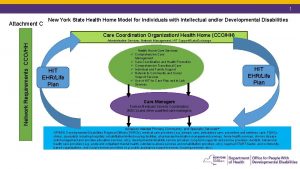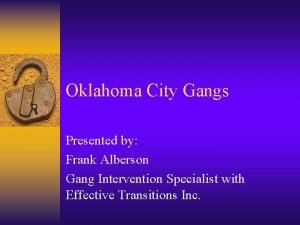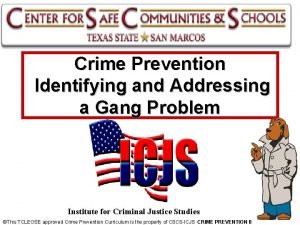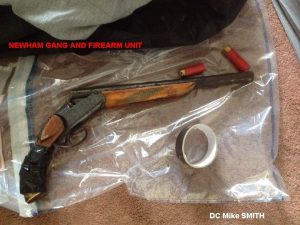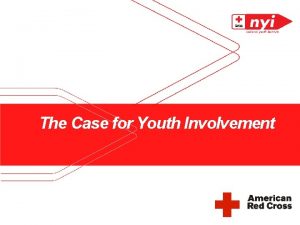Youth Gang Involvement Easter Young Healing Counselor Gangs















- Slides: 15

Youth Gang Involvement Easter Young Healing Counselor

Gangs Meet the Following Criteria: • They have a name or an identifiable leader. • They claim a geographic, economic, or criminal enterprise turf (territory). • They associate on a regular or continuous basis. • They engage in delinquent or criminal behavior. • Gangs often form along ethnic and racial lines. • They generally identify themselves by a name derived from - A street - Neighborhood - Housing project - Rock band or - Cult

WHY YOUTHS JOIN GANGS • Family Tradition – A kid may join a gang because their father, mother, brother, sister, cousin, uncle, aunt or other family member belonged to a gang. Generally, almost always, the involvement will be with the same gang as the other family member. • Family Problems – Lack of supervision by parents, involvement in abusive relationships, and such send youngsters looking for a role model whom they wrongly believe can be found in gang affiliation. • Excitement – Kids are by nature adventurous, inquisitive and often rebellious of authority. They want to test the wings and find their limits. Being involved in the gang lifestyle offers this to many kids, through the actions often demanded by gang members of other members to show loyalty or true affiliation. • Physical Protection – Kids often feel vulnerable or unsafe for a variety of reasons. This may be because of the neighborhood in which they live, the route they have to take to school or other routine activities, or even the school setting itself, when administrators and teachers allow bullying and intimidation to exist. Kids in these settings often feel the need for protection, and they are led to believe that involvement in a gang will provide that, to avoid becoming targets of violence.

WHY YOUTH JOIN GANGS • Peer Pressure - Many kids join a gang because their friends are gang members. They may be seeking love, attention, support, protection, or 14 merely acceptance by the group and are led to believe these missing components in their lives will be provided in a gang. • Financial Gain – Some kids may become involved in gangs because of the apparent ease of making large sums of money in a short period of time with relatively little effort. For example, selling drugs provided through the gang membership yields large amounts of money relatively quickly, particularly when compared to sacking groceries, delivering newspapers, and such. Kids generally tend to look at the short-term advantages, the money, and fail to grasp the long-term effects of illegal behavior. Too, kids have the perception that bad things (getting caught selling drugs) happen to other people, not them. • Respect – Kids want to be noticed and appreciated for themselves. When this recognition does not come from parents, teachers, or other adult role models, kids may turn to gangs because of the appearance that gang members have power over other people and are respected for their gang affiliation. The gang lifestyle becomes glamorized and internalized to provide a sense of being and self-worth not otherwise provided in the kid’s life.

QUICK FACTS ABOUT GANGS • It’s a national issue – there are over 30, 700 gangs in the US as reported in 2012 (National Youth Gang Survey – Dept. of Justice) • It’s an urban issue - all gang activity happens in metropolitan areas, specifically large cities (National Youth Gang Survey – Dept. of Justice) • Chicago is the gang capital of the United States. According to the Chicago Crime Commission • A 2012 Chicago Police Department gang audit found there are more than 600 gang factions in the city, with a minimum combined membership of 70, 000.

MAP OF CHICAGO NEIGHBORHOODS

MAP OF CHICAGO GANG TERRITORIES

SIGNS OF YOUTH INVOLVEMENT IN GANGS • • • Dropping or poor grades. Missing school or dropping out of school. Changing friends – begins to associate with known gang members. Irresponsible, arrogant or defiant attitudes or conduct. Intimidation is one of the primary weapons used by gang members. It is used for recruitment of other members, as well as in keeping rival members away. Gang members highly value their reputation, or “rep”, and therefore tend to act overly tough or aggressive, especially when confronted “fronted” by someone in authority while in view or proximity of their fellow gang members. Changing clothing and/or hairstyles, and appearance. Staying out late at night. Using alcohol and other drugs Having large sums of money.

SIGNS OF YOUTH INVOLVEMENT IN GANGS • Acquiring expensive items, such as jewelry, that cannot be explained. Many gang members wear somewhat gaudy or elaborate chains, earrings, and rings. Sometimes, rings may be made with multiple finger loops, for two, three (most common) or even four fingers. When done, these items essentially become weapons in the same manner of brass knuckles, as they are worn in the same manner. • Developing attitude and behavior problems. • Glamorizing and defending gangs. • Drawing and/or displaying gang graffiti on walls, books, clothes and similar items. This is one of the most common indicators in school that alert officials. Graffiti is used to identify gang members, mark territory or leave messages. It may be a memorial to a dead member, or it may be a threat, challenge or warning to rival gang members. The drawings may range from the very crude and simple to the very elaborate and imaginative, depending on factors such as location, ability of the artist, and time to complete the project before discovery.

SIGNS OF YOUTH INVOLVEMENT IN GANGS • Gang clothing or colors openly displayed or hidden under hats, coats or other clothing. Clothing style and color are strong indicators of gang affiliation as they indicate to everyone in the gang lifestyle the allegiance of the wearer. Colors are especially distinctive, as will be discussed in detail elsewhere. • Use of hand signals to communicate with friends. • Having photos showing gang names, slogans, or individuals known to be involved in gangs. • Use of gang style language. • Signs of bruising from initiation. • Tattoos of gang affiliation or affection. These may be crude or elaborate, and are normally found on the hands, arms or chest area, but they may also be found anywhere on the body.

SIGNS OF YOUTH INVOLVEMENT IN GANGS • Monikers – gang members commonly have nicknames, also known as street names that generally highlight some trait about them. • Use or exhibition of weapons. Weapons may range from clubs crudely made from a table legs and wrapped with tape for better grip, to baseball bats, sections of pipe, spiked wrist bands, chemical sprays, knives, handguns, shotguns, semi-automatic and fully automatic firearms. • Establishment of a turf or territory. This is the geographical area in which the gang lives, works or otherwise controls. It may be a block, a building or an entire neighborhood

HOW CAN WE HELP? • Educate yourself about gang territories and presence in your community • Support youth by being a positive adult role model and being an active presence in their lives • Identify youth who may be vulnerable and easy targets for gangs • If you are concerned about a youth and suspect that they are being intimidated by gangs or involved in gangs reflect and plan before taking action. Think about: - The youth and your relationship with them and interactions - The youth’s possible risk factors and protective factors - The resources you can provide for the youth to help • Work to prevent gang membership by talking to youth and helping them to make wise decisions

Changing Course: Preventing Gang Membership, (The National Institute of Justice) Examples of Key Points • The most common age for youth to join a gang is between 13 and 15, making early prevention efforts critical. • Young people join gangs for various reasons, including money, sense of support and belonging, peer status, perceived sense of protection, or to demonstrate an outlaw mentality. • Youth in gangs are more likely to abuse drugs, engage in high-risk sexual behaviors, and experience long-term health and social consequences. • Girls join gangs in large numbers, contrary to stereotypes. Prevention efforts should address girls' risk for gang joining, including preventing sexual abuse and addressing abusive intimate partner violence for girls. • Very early prevention efforts, particularly with families of young children, show promising results.

Changing Course: Preventing Gang Membership, (The National Institute of Justice) • Gang-joining prevention efforts should be informed by what is known about risk and protective factors for children of particular ages. There are protective factors, such as academic success, positive connections, and effective parenting that can help youth who are growing up in high-risk communities. • School-based programs addressing substance abuse, delinquency, and violence prevention have reduced risk factors for gang-joining when fully implemented. • Community partnerships can help reinforce and enhance the existing strengths of families and communities to reduce gang-joining, especially when supporting activities such as tutoring, mentoring, life-skills training, case management, parental involvement, and supervised recreation. • The public health approach — monitoring trends, researching risk and protective factors, evaluating interventions, supporting the dissemination and implementation of evidence-based strategies — is an important complement to law enforcement efforts.

NEXT STEPS More resources will be forthcoming via email and/or hard copy handouts THANKS
 Disney cruise youth activities counselor
Disney cruise youth activities counselor Youth involvement
Youth involvement Eddie easter
Eddie easter Pueblo co gangs
Pueblo co gangs Gangs of new york cda
Gangs of new york cda Gangs in the outsiders
Gangs in the outsiders Gang sign letters
Gang sign letters Juaritos okc
Juaritos okc Utah nortenos
Utah nortenos Victorian london gangs
Victorian london gangs Gangs
Gangs Tracey swena
Tracey swena Blackwater london gang
Blackwater london gang Exercise unit 1 english 11
Exercise unit 1 english 11 Los alisos middle school
Los alisos middle school Special education counselor
Special education counselor




